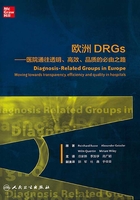
上QQ阅读APP看书,第一时间看更新
6.8 参考文献
Berki, S.E.( 1985). DRGs, incentives, hospitals, and physicians. Health Affairs (Millwood),4:70-6.
Böcking, W., Ahrens, U., Kirch, W., Milakovic, M. (2005). First results of the introduction of DRGs in Germany and overview of experience from other DRG countries. Journal of Public Health, 13:128-37.
Cots, F., Elvira, D., Castells, X., Sáez, M. (2003). Relevance of outlier cases in casemix systems and evaluation of trimming methods. Health Care Management Science,6:27-35.
Ellis, R.P. (1998). Creaming, skimping and dumping: provider competition on the intensive and extensive margins. Journal of Health Economics, 17:537-55.
Ellis, R.P., McGuire, T.G. (1986). Provider behavior under prospective reimbursement -cost-sharing and supply. Journal of Health Economics, 5:129-51.
Farrar, S., Yi, D., Sutton, M. et al. (2009). Has payment by results affected the way that English hospitals provide care? Difference-in-differences analysis. British Medical Journal, 339:1-8.
Fetter, R.B. (1991). Diagnosis-related groups - understanding hospital performance. Interfaces, 21:6-26.
Frant, H. (1996). High-powered and low-powered incentives in the public sector. Journal of Public Administration Research and Theory, 6(3):365-81.
Hafsteinsdottir, E.J.G., Siciliani, L. (2009). DRG prospective payment systems: refine or not refine? Health Economics, 19(10):1226-39.
Kahn, K.L., Rogers, W.H., Rubenstein, L.V. et al. (1990). Measuring quality of care with explicit process criteria before and after implementation of the DRG-based prospective payment system. Journal of the American Medical Association, 264:1969-73.
Kimberly, J.R., de Pouvourville, G., D'Aunno, T., eds (2008). The Globalization of Managerial Innovation in Health Care. Cambridge: Cambridge University Press.
Lave, J.R. (1989). The effect of the Medicare prospective payment system. Annual Review of Public Health, 10:141-61.
Lave, J.R. (2003). Developing a Medicare prospective payment system for inpatient psychiatric care. Health Affairs (Millwood), 22:97-109.
Levaggi, R., Montefiori, M. (2003). Horizontal and Vertical Cream-Skimming in the Health Care Market. DISEFIN Working Paper, 11/2003. Rochester, NY: Social Science Research Network (http://ssrn.com/abstract=545583, accessed 10 July 2011).
Martinussen, P.E., Hagen, T.P. (2009). Reimbursement systems, organizational forms and patient selection: evidence from day surgery in Norway. Health Economics, Policy and Law, 4:139-58.
MDS( 2011). Abrechnungsprüfungen derMDK in Krankenhdusern sind angemessen, wirtschaftlich und zielführend. Zahlen und Fakten der MDK-Gemeinschaft. Essen: Medizinischer Dienst des Spitzenverbandes Bund der Krankenkassen e.V.
Miraldo, M., Goddard, M., Smith, P. (2006). The Incentive Effects of Payment by Results.York: University of York Centre for Health Economics (CHE Research Paper 19).
Newhouse, J.P., Byrne, D.J. (1988). Did Medicare's prospective payment system cause length of stay to fall? Journal of Health Economics, 7:413-16.
Schreyögg, J., Stargardt, T., Tiemann, O., Busse, R. (2006). Methods to determine reimbursement rates for diagnosis-related groups (DRG): a comparison of nine European countries. Health Care Management Science, 9:215-23.
Silverman, E., Skinner, J. (2004). Medicare up-coding and hospital ownership. Journal of Health Economics, 23:369-89.
Simborg, D.W. (1981). DRG creep: a new hospital-acquired disease. New England Journal of Medicine, 304:1602-4.
Steinbusch, P.J., Oostenbrink, J.B., Zuurbier, J.J., Schaepkens, F.J. (2007). The risk of upcoding in casemix systems: a comparative study. Health Policy, 81:289-99.
(骆向兵 译)